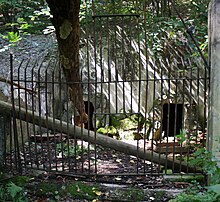Tübingen Zoo
| Tübingen Zoo | ||
|---|---|---|
| place | Schloßbergstrasse 10 72070 Tübingen |
|
| surface | 23 acres (around 7.2 hectares) | |
| opening | May 19, 1907 | |
| organization | ||
| management | Eugen Mannheim | |
|
Economy Ödenburg and Tiergarten by Eugen Mannheim near Tübingen on a postcard from the Metz brothers from 1907 |
||
|
|
||
Coordinates: 48 ° 30 '25.7 " N , 9 ° 1' 39.1" E

The Tübingen Zoo was a zoo in Tübingen that existed from 1907 to 1919 . At the time it was mostly named after its owner Mannheims Tiergarten , later Mannheims Tierpark .
history
Eugen Mannheim (1879–1974), who grew up in Tübingen, built a small private zoo at Schlossbergstrasse 10 in Tübingen at the beginning of the 20th century. In 1906 he bought a 23 acre (around 7.2 hectare) property consisting of forest and meadows near the recently burned down Ödenburg am Spitzberg above the Neckar valley upstream from Tübingen, where he had a farm building , two barns, houses with several departments for big cats, Bears and cattle, enclosures for birds and other animals and ponds for otters and seals were built. The Ödenburg building became a catering business. He took over part of the animal population and the equipment from Nill's zoological garden in Stuttgart, which existed from 1871 to 1906. On May 19, 1907, he opened the Tübingen Zoo.
An inventory of animals has not survived, but according to newspaper reports in the Tübinger Chronik , the zoo housed a total of nine lions (two of which were born in the zoo) and twelve polar bears and brown bears , as well as a king tiger , a leopard , two pumas , three ocelots , wolves , and marmosets , Crab-eating and rhesus monkeys , seals , griffon vultures , deer , badgers , wild boars , cockatoos , parakeets and a Mississippi alligator , which, like some other reptiles, was housed in the restaurant building due to its heat requirements. Seals were only temporarily in the zoo due to their need for fish.
The entrance fee for adults was 20 pfennigs , reduced half. Mannheim organized various kinds of music events in the Ödenburg building. On June 22, 1907, King Wilhelm II visited the zoo and then had a donation of 20 marks transferred. In 1910, over 2,000 students from the Tübingen, Reutlingen and Rottenburg authorities visited the zoo. The zoo received support from the city in the form of a tax rebate, and it slaughtered three horses every week on its own for its feed.
In 1914 Mannheim was drafted into the military three days after the start of World War I , which led to the demise of the zoo, which was closed in 1919. Mannheim then ran a farm, the last inner-city farm in Tübingen.
Some of the cages and predator corridors have been preserved in the forest to this day ( location of the old cage ).
literature
- Günter Schmid: Mannheim's zoo on the Ödenburg . In: State Office for Nature Conservation and Landscape Management Baden-Württemberg (Ed.): The Spitzberg near Tübingen. The nature and landscape protection areas of Baden-Württemberg . tape 3 . Ludwigsburg 1966, p. 17-27 .
- Albrecht Faber, Tübingen in the 50s , p. 82.
Individual evidence
- ↑ Between tiger and rabbit fur: the small animal breeders' association was founded in 1904. History portal Zeit -zeugnisse, Schwäbisches Tagblatt ( memento from September 19, 2012 in the web archive archive.today ).
- ↑ The Tübingen Ödenburg is probably described in Hölderlin's poem Die Burg , cf. Ernst Mögel: Hölderlin's "Burg Tübingen" - a poem about the Ödenburg.
- ↑ Nill's Zoological Garden 1906 ( Memento from March 4, 2016 in the Internet Archive ). Stuttgarter Zeitung , accessed June 26, 2009.
- ↑ The polar bears of the Sopron. Reutlinger General-Anzeiger , December 30, 2008, accessed December 16, 2009.
- ↑ Those were the days. Schwäbisches Tagblatt , March 7, 2007, accessed June 26, 2009.


